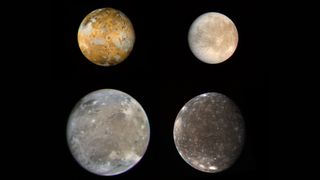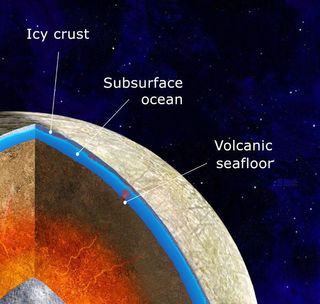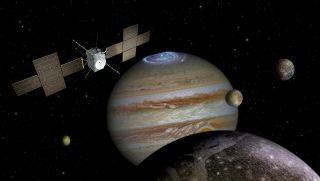This article was originally published on The conversation. The publication contributed the article to Space.com Expert voices: opinion pieces and insights.
Mike Sori is an assistant professor of planetary sciences at Purdue University.
On October 14, 2024, NASA launched a robotic spacecraft called Europa Clipper to Jupiter’s moons. Clipper will reach Jupiter’s ice-covered moon Europe in 2030 and spend several years collecting and returning valuable data on the moon’s potential habitability Earth.
Clipper isn’t the only mission highlighting researcher interest Jupiter and its mane.
On April 13, 2023, the European Space Agency launched a rocket with a spacecraft bound for Jupiter. The Jupiter icy moon explorer – or JUICE – will spend at least three years on Jupiter’s moons after arriving in 2031.
I’m a planetary scientist who studies the structure and evolution of solid planets and moons in the solar system.
There are many reasons why my colleagues and I are looking forward to receiving the data Europa Clipper and JUICE will hopefully be returned to Earth in the 2030s. But perhaps the most exciting information will have to do with water. Three moons of Jupiter – Europa, Ganymede And Callisto – are home to vast, underground oceans of liquid water that could support life.
Related: SpaceX Falcon Heavy rocket launches NASA’s Europa Clipper probe to explore icy Jupiter ocean moon (video)

Meet Io, Europa, Ganymede and Callisto
Jupiter has dozens of moons. Four of them are of particular interest to planetary scientists.
Io, Europa, Ganymede and Callisto are, like Earth’s Moon, relatively large, spherical, complex worlds. Two previous ones NASA missions have sent spacecraft to the Jupiter system and collected data about these moons. The Galileo mission orbited Jupiter from 1995 to 2003 and led to geological discoveries on all four major moons. The Juno mission still orbits Jupiter and has given scientists unprecedented insight into Jupiter’s composition, structure and structure room environment.
These missions and other observations brought that to light Iothe closest of the four to its host planet, is buzzes along geological activityincluding lava lakes, volcanic eruptions and tectonically formed mountains. But it is not home to large amounts of water.
Europe, Ganymede and Callisto, on the other hand, have icy landscapes. The surface of Europe is a frozen wonderland with a young but complex history, possibly including icy analogues of plate tectonics and volcanoes. Ganymede, the largest moon of all solar systemis greater than Mercury and has its own magnetic field generated internally from a liquid metal core. Callisto seems somewhat inert compared to the others, but serves as a valuable time capsule of an ancient past that is no longer accessible on the youthful surfaces of Europa and Io.
Most exciting of all, Europa, Ganymede, and Callisto almost certainly all possess it underground oceans of liquid water.

Ocean worlds
Europa, Ganymede and Callisto have cold surfaces hundreds of degrees below zero. At these temperatures, ice behaves like solid rock.
But just like the earthThe deeper you go underground on these moons, the hotter it gets. Go down far enough and you’ll eventually reach the temperature where ice melts into water. Exactly how far this transition occurs on each of the moons is a subject of debate which scientists hope to solve with JUICE and Europa Clipper. Although the exact depths are still uncertain, scientists are confident that these oceans exist.
The best evidence of these oceans comes from Jupiter’s magnetic field. Salt water is electrically conductive. As these moons travel through Jupiter’s magnetic field, so do they generate a secondary, smaller magnetic field that signals to researchers the presence of an underground ocean. Using this technique, planetary scientists have been able to demonstrate that the three moons contain subsurface oceans. And these oceans are not small; the ocean of Europa alone could hold more than that double the water of all the oceans on Earth combined.
An obvious and tantalizing next question is whether these oceans can support extraterrestrial life. Liquid water is an important part of what makes the world habitable, but far from the only requirement for life. Life also has needs energy and certain chemical compounds next to water to bloom. Because these oceans are hidden beneath miles of solid ice, sunlight and photosynthesis are off. But it is possible that other sources can provide the necessary ingredients.
On Europa for example, the ocean with liquid water covers a rocky interior. That rocky seabed could provide energy and chemicals through underwater volcanoes that could make Europe’s ocean habitable. But it’s also possible that the European ocean is a sterile, inhospitable place – scientists need more data to answer these questions.

Upcoming missions from ESA and NASA
Europa Clipper and JUICE were set up to provide scientists with groundbreaking information about the potential habitability of Jupiter’s moons. Although both missions will collect data from multiple moons, JUICE will spend money time orbiting and aimed at Ganymede, and Europa Clipper will make dozens of short flights past Europa.
Both spacecraft will carry a range of scientific instruments built specifically to explore the oceans. The onboard radar makes Europa Clipper and JUICE possible to explore the moons’ outer layers of solid ice. Radar could reveal small amounts of liquid water in the ice, or, in the case of Europa, which has a thinner outer ice layer than Ganymede and Callisto, hopefully detect the larger ocean.
Magnetometers will be too on both missions. These tools will give scientists the opportunity to study in detail the secondary magnetic fields produced by the interaction of conducting oceans with Jupiter’s field and will hopefully give researchers clues about the salinity and volumes of the oceans.
Scientists will also observe small variations in the moons’ gravity by monitoring subtle movements in the orbits of both spacecraft, which could help determine whether Europa’s seafloor has volcanoes that provide the necessary energy and chemistry that the ocean supports life.
Finally, both craft will carry a host of cameras and light sensors that will provide unprecedented images of the geology and composition of the moons’ icy surfaces.
Perhaps one day a spacecraft will be able to drill through the miles of solid ice of Europa, Ganymede or Callisto and explore the oceans directly. Until then, observations from spacecraft like Europa Clipper and JUICE are the best choice for scientists to learn more about these ocean worlds.
When Galileo When they discovered these moons in 1609, they were the first objects known to directly orbit another planet. Their discovery was the final nail in the coffin of the theory that centers the Earth – and humanity the universe. Perhaps these worlds have yet another humbling surprise in store.



/cdn.vox-cdn.com/uploads/chorus_asset/file/25716336/2401_main_murata.jpg?w=445&resize=445,265&ssl=1)